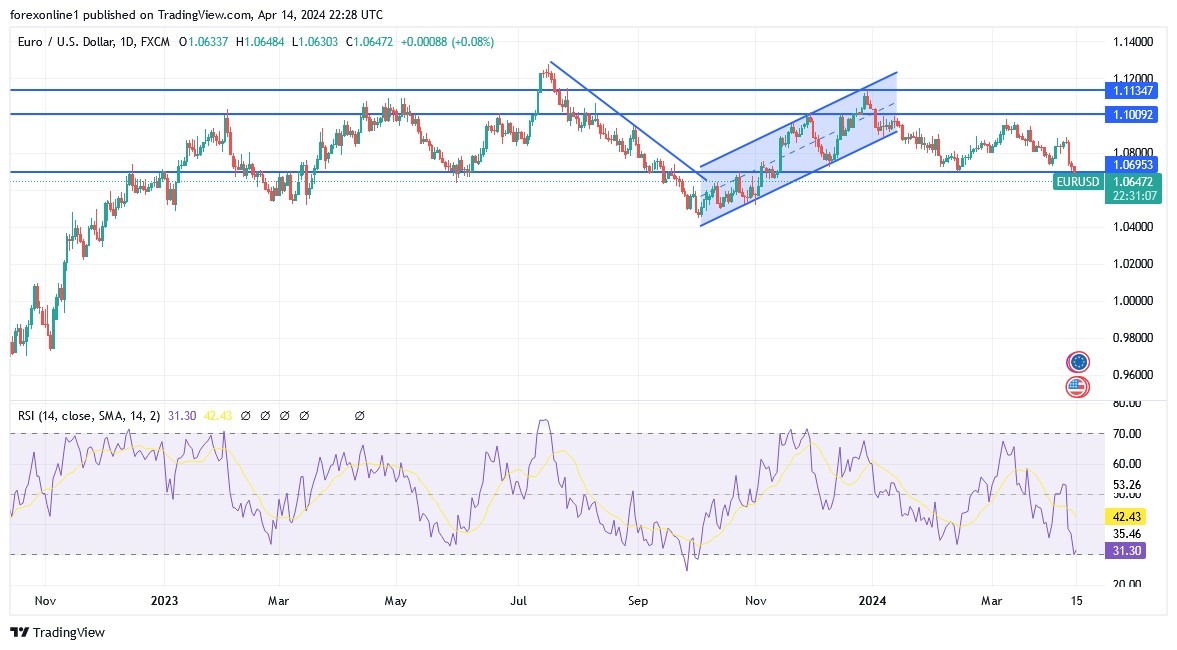- The EUR/USD fell to a five-month low of 1.0622 support amid risk aversion and a negative outlook for the future of ECB policy at the end of last week's trading.
- The losses of the most popular currency pair in the forex market increased under pressure from divergent scenarios for the ECB and the Federal Reserve, and increased demand for the US dollar due to geopolitical turmoil.
For its part, the ECB left interest rates unchanged at its April meeting and indicated that if core inflation continues to slow at the expected pace, it may be appropriate to ease monetary tightening in June. Such a move is in stark contrast to the expected path of the Federal Reserve, after evidence that US inflation is holding at levels above the Fed's target has prompted markets to delay bets on the first Fed rate cut from June to September. The divergence between the two policy outlooks has been exacerbated by geopolitical concerns over the increasingly hostile environment between Israel and Iran, leading to escalating war fears and driving emerging markets around the world to rely on the US currency.
Top Forex Brokers
So, what is the expected outcome for the EUR/USD in the coming days?
The EUR/USD price trend is now more bearish, according to Fuad Razakzadeh, market analyst at City Index. The EUR/USD trend is now more bearish. Last week's trading saw the EUR/USD break below some key support levels, initially breaking 1.0795 and now falling below the 1.0695-1.0725 pivot area. Clearly, this area provided strong support in December and again in February.
The EUR/USD also broke below the upward trend line that had been in place since October. And with the 21-day EMA falling below the 200 SMA, this is another bearish signal. With price action below these moving averages, this suggests that the path of this resistance is clearly on the downside. Therefore, we expect the EUR/USD to likely decline to the 1.06 support initially before 1.05 and possibly test October's low of 1.0448 after that.
On the upside, resistance now comes in at the broken support area I mentioned between 1.0695 and 1.0725. If we break above that, the next resistance line or potential resistance comes in at around 1.0795 followed by 1.0835. These were previous support levels as mentioned. Pressure on the EUR is mounting as the gap between expected rate cuts from the Fed versus the ECB widens to its widest this year. The latter is moving towards cutting rates properly while extending the timetable for the former. As of this writing, the EUR/USD was trading at its lowest since mid-November, after breaking below key support in the 1.0695-1.0725 areas.
Overall, we may see the US dollar price remain supported on any short-term declines, as the interest rate story in the US and the rest of the world – for example, the European Central Bank and the Bank of Canada – becomes more positive for the dollar. Recently, the EUR/USD rate has been stuck in a very tight range in recent months and never looked like it was about to take off anytime soon anyway, all thanks to continued weakness in Eurozone data. Their recent weakness reflects the growing divergence in interest rate paths between the United States and the Eurozone.
Currently, traders not only see a greater chance of an ECB rate cut in June compared to the Fed, but they are also factoring in more cuts overall for 2024. Naturally, the US dollar side of the story stems from the sticky nature of inflation in the US, the surprising resilience of data strength overall – plus rising crude oil prices, which is always positive for the dollar. Also, US consumer prices rose to their highest annual pace since October in March, hitting 3.5% mid-week.
Meanwhile, this was the fourth consecutive month that the CPI has exceeded market expectations, as prices for many essential items rose sharply, including car insurance, transportation, and hospital services, not to mention rent, electricity, and restaurants.
On the Eurozone side, a weak economy and cold price pressure have increased pressure on the European Central Bank to cut interest rates sooner rather than later. For her part, European Central Bank President Christine Lagarde acknowledged on Thursday the possibility of a reduction in June. Apparently, as many as five members of the ECB's Governing Council appeared to call for lower interest rates at a meeting on Thursday, according to Bloomberg. The consensus suggests that the first phase of interest rate cuts by the ECB could lower the deposit rate by around 100 basis points from 4%.
EUR/USD Technical Analysis and forecast:
Amid increasing global geopolitical tensions, especially in the Middle East region after the Iranian strikes, the gains of the US dollar will remain stronger and continue. Therefore, we expect a downward trend in the EUR/USD pair, despite its recent losses, moved some technical indicators towards strong saturation levels for selling, according to the performance on the daily chart. Currently, the closest support levels for the current trend are 1.0590 and 1.0455, respectively. From the last level, it is preferable to return to buying euros and dollars, but without risk. On the other hand, over the same period, the current downward trend will not be broken without returning to the resistance levels of 1.0775 and 1.0830, respectively.
Ready to trade our Forex daily forecast? We’ve shortlisted the top forex brokers in the industry for you.

